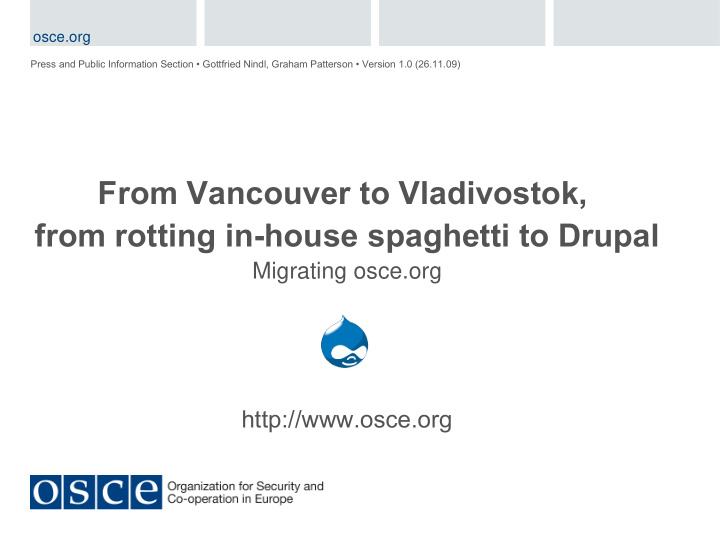



osce.org Press and Public Information Section • Gottfried Nindl, Graham Patterson • Version 1.0 (26.11.09) From Vancouver to Vladivostok, from rotting in-house spaghetti to Drupal Migrating osce.org http://www.osce.org
Content About the OSCE Business Case Information Architecture Software Architecture Migration Usability Testing Conclusion 2
About the OSCE 3
What is the OSCE? World’s largest regional security organization History: Cold War and Berlin Wall Comprehensive approach to security Forum for dialogue Practical work in the field 4
Where is the OSCE? 56 participating states, 18 field missions… ...from Vancouver to Vladivostok 5
Business Case 6
Motivation Large decentralized website Small central webteam Inflexible technology (CMS) Rigid content model Confusing information architecture Search engine (un)optimization 7
Objectives Multilingual capability Better workflow Better content organization Improved information architecture Flexible, community-maintained CMS SEO 8
Open Source CMS Evaluation 4 serious candidates Drupal (PHP) Repository Plone (Python) URL structure Security Building modules Technology Building forms TYPO3 (PHP) Content types Perspective Templating Content Delivery Search Engine OpenCMS (Java) Back-end Scalability 15 criteria 9
So, why Drupal? Pros > Best balance between core features and simplicity > Small core (footprint), numerous useful modules > Large, friendly community > Reference sites Cons > Back end usability > No high-level Ajax support > Ancient design (no OO!) 10
Proof of Concept Can the chosen CMS deliver? Tasks > Front end theme => easy, by templating > Content types => hard, custom modules > Workflow => good enough > Data migration => Use APIs, e. g. node > SEO => clean URLs, taxonomies Lessons learned > Drupal can do almost anything we can think of > Drupal needs a roadmap > Buggy modules > Active participation in community recommended 11
Information Architecture 12
Content Model 40 sub sites & portals 22 content types 12 field types 15 vocabularies Node queues & rules Numerous views 13
Implementation Sub sites & portals as tagged pages CCK for content typing Vocabularies as conditionals ‘Hot content’ as node queues Views for generic lists 14
Software Architecture 15
High Availability/Performance Cluster Cost-effective solution Squid proxy boosts performance Service failover Heartbeat monitors servers DRDB replicates databases/files 16
Software Design Patterns Single entry point Front Controller Notify responsible Observer/Visitor Action Procedure Modules Extension by convention Transaction Script Class Table Db Inheritance Plugins Flexible data model Embedded markers & scriptlets Template View 17
Used Modules (currently 38) Content: Development: CCK, Content Taxonomy, Date, Email, Filefield Filefield Paths, Imageapi, Imagecache, Devel, SimpleTest Imagefield, Link, Nodereference Explorer, Nodequeue, Phone, Quotation (custom) Workflow: User Interface: Rules, Workflow Admin Menu, FCK Editor, JQuery UI, JQuery Update, Menu Block, Lightbox2 ,Views, Misc: Taxonomy Navigation (custom) Apache Solr, Hash tokens (custom), Import/Export: i18n, Pathauto, Querypath, Subscriptions, Token Data Migration (custom), Import, Node Export, Taxonomy Export, Gateway (custom) 18
Migration 19
Approach Three phase strategy: > Data extraction > Data mapping > Data verification Content Audit > Spot checks to fix biggest issues Custom import script > CCK nodes & Aliases (ca. 50,000 items) > Menus > Taxonomies > Users > Subscriptions 20
Implementation Complex data extraction strategies (SQL) Flag and mark items Import module: http://drupal.org/project/import > Uses batch API (progress bar) > Hook import_stage() > Hook import_process() OO batch factory with identity map for creating assets, references & assignments Verify results with Simpletests: http://drupal.org/project/simpletest 21
Usability 22
Problems Back end usability poor (especially for non-geeks) The UI is not very scalable Built-in widgets are very cumbersome No high-level Ajax library Custom implementation required (Nodereference Explorer) 23
Nodereference Explorer Context 24
Our solution: Nodereference Explorer Project http://drupal.org/project/nodereference_explorer Metaphor: File Explorer Responsive dialog (overlay) Customizable components > Theme > Displays > Filters > Preview Demo link 25
Community Quite small project Start February 2009 Maintaining is time intensive 73 issues focus on functionality, hardly on design Great community => Thank you very much!! BUT, think about new ways of collaboration, apart from issue list … 26
Testing 27
General testing No battle plan survives contact with the enemy – Field Marshal von Moltke No website survives contact with its users – OSCE webteam Beta site under construction Internal and external testers Formal (recorded) and informal (ad-hoc) tests Front-end and back-end 28
Usability testing Front end > IA (clear enough?) > Navigation (ease of use) > Findability (organizational structure vs thematic vs geographic) > Responsiveness Back end > Need to manage transition from a simpler CMS > Are typical users (non-geeks) comfortable with the interface? > Common tasks should be quick and easy > Are steps to complete a task memorizable? > How do users react if they can’t complete a task? > What help is available? 29
Conclusion 30
Conclusion Drupal will be a big step forward for the OSCE Great contributions from community – thank you! Contributing back and maintaining: Nodereference Explorer But… feedback from testing and post-launch crucial Questions, comments…? 31
Contact Velimir Alic (Public Website Manager): User ID 406104 Gottfried Nindl (Web Developer): User ID 421442 Webteam: webteam@osce.org Front End Developer needed: apply at http://employment.osce.org till December 3 rd , 2009 32
Recommend
More recommend